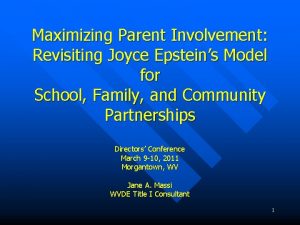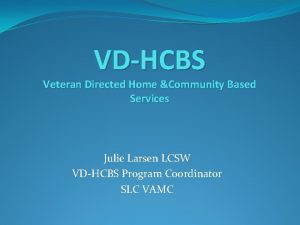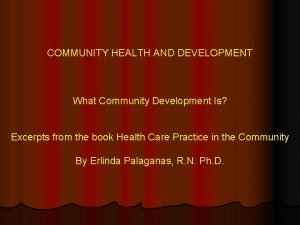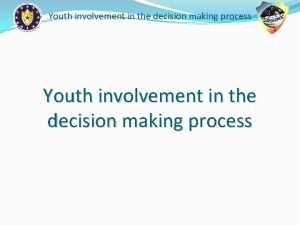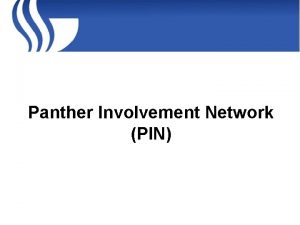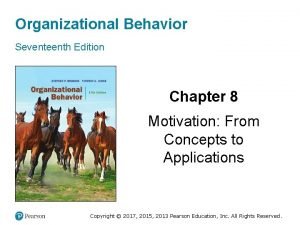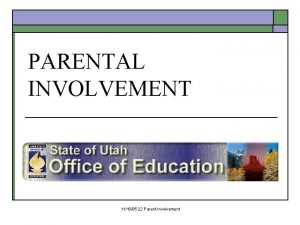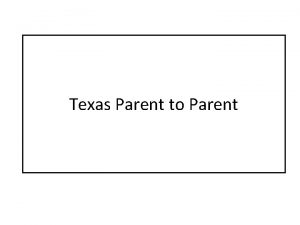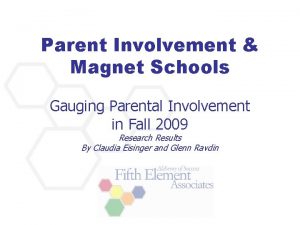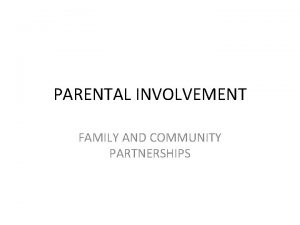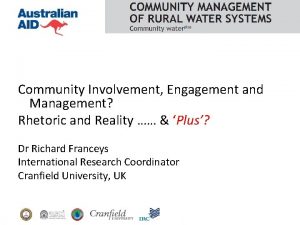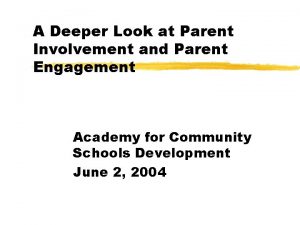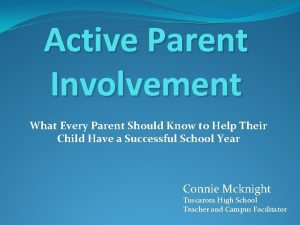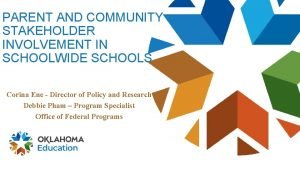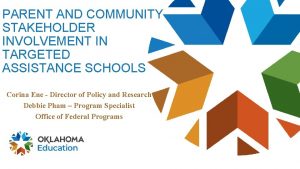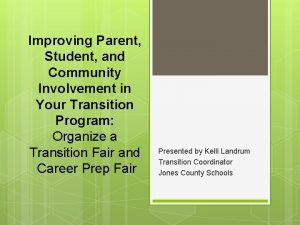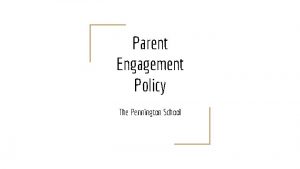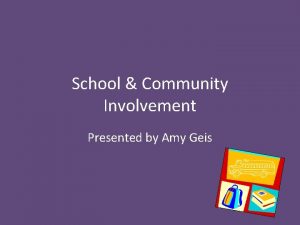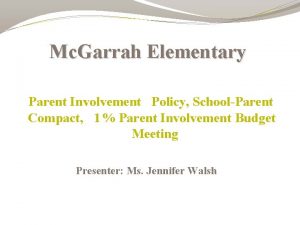HOME SCHOOL Parent Involvement Policy and Reality Community































- Slides: 31

HOME & SCHOOL: Parent Involvement Policy and Reality Community Engagement, Climate & Outcomes Comparing Two Elementary Schools by S. Elizabeth Lockman April 30, 2015 Contemporary Issues in Education Policy Spring 2015

Parent Involvement: Why? Current Models Parent Involvement Policy Parent Involvement: How? Literature Fed, State & LEA Parent Involvement Support Involvement in Practice Outside Orgs Local Case Study: 2 School Comparison Parent Involvement: What Next? Current Gaps & Future Models

Parent Involvement: Why? Primary: What is the relationship between parent involvement and student and school performance? Is it a continuum? Secondary: Can community connectedness impact student performance for the disadvantaged through increased parent involvement?

Parent Involvement: Why? Literature Review MANY studies have linked parent involvement to measureable outcomes. Focus on the following relevant studies: Izzo, Weissberg, Kasprow & Fendrich (1999). Sheldon (2003) Distance between home & school practical understanding. Emphasis on traditional engagement practice exacerbates achievement gaps. Lee & Bowen (2006) Unequal opportunities and benefits of involvement.

Parent Involvement: How? Nationally accepted best practices and standards for involvement. Joyce Epstein’s Six Types of Parent Involvement Parenting Communicating Volunteering Learning at Home Decision Making Collaborating with Community Seen as levels? A continuum?

Parent Involvement Policy Federal Education Agency ESEA, Title I, Part A, Sec 1118 “parental Involvement” Part of Johnson’s War on Poverty Laid groundwork for targeting parent involvement as tool for improved outcomes for disadvantaged students, since initial passage (1965) Survived multiple reauthorizations Serves schools from 40 -50% low income Regulation reduced in 1980 s, restored in 1990 s Some funding automatic, some grant-based to SEA/LEA

Parent Involvement Policy Federal Education Agency ESEA, Title I, Part A, Sec 1118 “parental Involvement” Today – No reauthorization since NCLB Focus on Accountability/Transparency Blueprint for Reform Turnarounds, 21 st Century Learning Centers, Promise Neighborhoods Mechanisms: Race to the Top, ESEA Waivers

Parent Involvement Policy State Education Agency Compliance with Federal Law ESEA Waiver – Priority School recommendations Delaware State Parent Advisory Council Representatives from LEAs Intended to influence policy decisions

Parent Involvement Policy Local Education Agency Must have Title I parent involvement policy for schools and students May set additional policy for non Title 1 schools, may not expend funds on them Funding for: Targeted programs for affected students Hosting parent advisory councils (PACs) and programs Parent Universities Fund parent Involvement programming on school level, not more than 1%

Parent Involvement Policy Case of Red Clay Consolidated School District Strategic Priority #5: Family & Community Engagement RCPAC Inclusive of all schools; membership heavily favors affluent schools Parent University Other District Title I expenditures: Annual Family Resource, College Fairs (transportation provided) Direct student academic programming (instruction, extra support) Disburse school-level parent involvement grants (must apply, meet guidelines)

Parent Involvement Policy School Level Administrators “Inform & involve” parents in improvement planning Coordinate programs to strengthen parent/teacher capacity for involvement Evaluate efficacy Teacher Communicate, offer opportunities for meaningful & authentic engagement NEA Guidance supports Epstein’s Framework Parent Communicate, take advantage of opportunities

Parent Involvement Support Key Non-governmental Orgs Parent-Teacher Association (PTA) Provides models, guidelines, training for strengthening involvement Provides 501(c)3 status autonomous of school Fee-based; Administrative requirements Parent Information Center (PIC) Advocacy guidance & training, particularly for special needs students

Local Study Design Picked two Schools in Red Clay School District, with PTAs Demographic Comparison Success Indicators Climate Metrics Recent Parent Organizational Activity

School A Demographic Profile Students: 317 95% African American 93. 4% FR Lunch 14. 2% Special Education Staff: Race: 69% AA, 29% White, 2% Hispanic Gender: 76% Female, 24% Male Degrees: 60% MA, 33% BA, 7% <BA Experience: 23% <5, 40% 5 -15, 37% > 15

School B Demographic Profile Students: 751 73% White, 20. 9% “Other” (primarily Asian) 8. 1% FR Lunch <5% Special Education, <5% ELL Staff: Race: 92% White, 5% Asian, 3% AA Gender: 86% Female, 14% Male Degrees: 66% MA, 30% BA, 4% <BA Experience: 12% <5, 44% 5 -15, 44% > 15

School A Success Test Scores ELA: 3 rd 35% (661. 55), 4 th: 43. 4 % (719. 53); 5 th 50% (737. 79) Math: 3 rd 30% (608. 43), 4 th: 37% (689. 5); 5 th 50% (733. 24) Discipline/Retention 80 students (24%) received 153 suspensions (all but one out-of-school), totaling 231 suspended days – district avg is 13%, state 9% Fighting/Disorderly, Offensive Touching, Bullying 0 expulsions Priority School Status Indicators

School B Success Indicators Test Scores ELA: 3 rd >95% (779. 92), 4 th: 94% (805. 22); 5 th >95% (843. 06) Math: 3 rd >95% (774. 21), 4 th: 90% (796. 4); 5 th 91% (829. 11) Discipline/Retention Zero Disciplinary Actions

School A Parent-led PTA of two officers 40 members: 26 parents, 14 staff Budget Partnership with Children & Families First, paid staff support Membership Org Raised $11, 318. 18, spent $2839. 06, $8479. 12 Balance Programming 7 -13 fundraising projects, org fees, 2 events

School B Parent Org Parent-led PTA of nine officers (including past pres), 25 chaired committees Membership Budget 360 members: approx. 300 parents, 60 staff Raised $11, 857. 10, spent $7, 991. 95. $27, 019. 24 Ending Balance Programming 4 -5 fundraising projects, org fees, 4 -5 events, 15 -20 enrichment programs & assemblies, staff support & appreciation gifts and grants (for supplies et al)

School A Climate Survey Highlights Overall Standard Scores (85 -115 w/in 1 std dev of mean) Students: 90. 14 Teachers: 85. 65 Parents: 96. 14 Student Satisfaction – Most: Students Engaged (98); Least: Peer relations (88) Teacher Satisfaction – Most: Clarity Expectations(94); Least: Respect Diversity(84) Parent Satisfaction – Most: Home-School Comm (99); Least: School Safety (88)

School B Climate Survey Highlights Overall Standard Scores (85 -115 w/in 1 std dev of mean) Students: 106. 77 Teachers: 103. 75 Parents: 102. 17 Student Satisfaction – Most: Bullying (87); Least: Clarity of Expectations (101) Teacher Satisfaction – Most: Students Engaged (107); Least: Staff Relations (98) Parent Satisfaction – Most: Peer Relations (104); Least: Fairness of Rules (98)

Comparison Key Similarities in Parent Engagement Practice PTAs: Similar schoolwide events & fundraisers Parent Satisfaction closest to mean of three stakeholder groups at each school

Comparison Key Differences in Practice School A Currently works primarily through service agency Spends more time fundraising from school community School B Contributes heavily to programmatic delivery through purchasing, grant-making More events and after-school programming due to parentstaffing

Parent Involvement: What Next? Future Models Social capital building (Bolivar & Chrispeels, 2011) Sustained organization is well-served through improved understanding of and access to agencies above teacher/school leader Shift from individual/meritocratic practices (Carvalho, 2001) Current policy (or lack thereof) further disadvantages already disadvantaged students; ie. expected homework help – wrong place to start

Parent Involvement: What Next? Future Models Schoolcentric to Communitycentric (Lawson, 2003) Community concerns should be addressed and incorporated into parentteacher co-development & vice versa Revisiting the “Continuum” (Schutz, 2006) Current practices stop short; view involvement types as a progression Too much responsibility to teachers; often disconnected from community being served

Parent Involvement: How? Revisiting the “Continuum” BASELINE, NOT END GAME Parenting Communicating CULTURAL/MERITOCRATIC – barrier, de-emphasize? Volunteering Learning at Home NECESSARY AUTHORITY & COLLECTIVE ACTION – gap, prioritize? Decision Making Collaborating with Community

Conclusions, Ideas Orientation to individual families, rather than collective needs could be inhibiting progress, up to LEA level. “Squeaky wheel syndrome”. Individual orientation, consumer-style, has deficits for affluent as well, but they have wherewithal to withstand them Conformity to standard involvement practice, while not compulsory, is common, and can be a barrier to meaningful, authentic engagement Weak language in policy – “may”, involve”, “participate”, “inform”, gives no real authority to parent/community

Conclusions, Ideas Civil rights/grassroots advocacy training as/more valuable than “services”, more effective with collective than individual orientation Capacity & sustainability of organizing among low-capital parents over time is critical Parent/community agency over school-level expenditures, vs. LEA

Parent Involvement: What Next? Next To question… what extent does implementation of Title I funding/policy support meaningful engagement in disadvantaged school environments, as its intent states?

Thank you!

References Bolívar, J. M. , & Chrispeels, J. H. (2011). Enhancing parent leadership through building social and intellectual capital. American Educational Research Journal, 48(1), 4 -38. Carvalho, M. E. P. (2001). Rethinking family-school relations: A critique of parental involvement in schooling. Mahwah, N. J: L. Erlbaum Associates. Izzo, C. V. , Weissberg, R. P. , Kasprow, W. J. , & Fendrich, M. (1999). A longitudinal assessment of teacher perceptions of parent involvement in children's education and school performance. American Journal of Community Psychology, 27(6), 817 -839. Lawson, M. A. (2003). School-family relations in context: Parent and teacher perceptions of parent involvement. Urban Education, 38(1), 77 -133. Lee, J. , & Bowen, N. K. (2006). Parent involvement, cultural capital, and the achievement gap among elementary school children. American Educational Research Journal, 43(2), 193 -218 Schutz, A. (2006). Home is a prison in the global city: The tragic failure of school-based community engagement strategies. Review of Educational Research, 76(4), 691 -743. Sheldon, S. B. (2003). Linking school-family-community partnerships in urban elementary schools to student achievement on state tests. Urban Review, 35(2), 149 -165.
 Joyce epstein model
Joyce epstein model A national policy of avoiding involvement in world affairs
A national policy of avoiding involvement in world affairs Mobile home exchange
Mobile home exchange Oak springs mobile home park
Oak springs mobile home park Gaisce.ie
Gaisce.ie Veterans directed home and community based care
Veterans directed home and community based care Veterans directed home and community based care
Veterans directed home and community based care Nursing home social media policy
Nursing home social media policy Arti dari homecare
Arti dari homecare Perbedaan home care dan home visit
Perbedaan home care dan home visit Unit 3 home sweet home
Unit 3 home sweet home Come home come home jesus is calling
Come home come home jesus is calling America my home sweet home
America my home sweet home André fougeron
André fougeron She said that, home economics stands for the ideal home.
She said that, home economics stands for the ideal home. Home sweet home: survive
Home sweet home: survive Pathogram theory examples
Pathogram theory examples Tiny homes in las vegas
Tiny homes in las vegas Home visit assignment
Home visit assignment Phases of home visiting
Phases of home visiting Principles of community health
Principles of community health Involvement decision making
Involvement decision making Total member involvement pdf
Total member involvement pdf Panther involvement network
Panther involvement network What are the 7 principles of social work?
What are the 7 principles of social work? Panther involvement network
Panther involvement network Pin network gsu
Pin network gsu How can employee involvement measures motivate employees
How can employee involvement measures motivate employees Tunnel preparation in furcation
Tunnel preparation in furcation Brazil ww2 involvement
Brazil ww2 involvement Active community participation definition
Active community participation definition What drove european involvement in asian commerce
What drove european involvement in asian commerce
